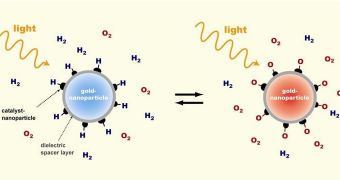A team of scientists has recently managed to produce a new type of measurement technology that relies on the optical resonances that form inside nanoparticles. These so-called plasmon resonances may prove to be the basis for a new class of sensors, experts from the Chalmers University of Technology, who have been behind the innovation, report. Details of the find appear in the latest Web issue of Science Express, and have also been accepted for publication in a new paper to appear in the November issue of the top journal Science, AlphaGalileo reports.
The peculiar type of resonances, which can only be found in nanoparticles, has been under intense scientific scrutiny for the past ten years, as experts believe that it may be of great use in the field of optoelectronics, and also for detecting biological molecules. The Swedish team has proven in the new investigation that it can utilize the plasmon resonances to construct extremely sensitive sensors that could be used to identify contaminants in a solution or in the air at a concentration of just a few parts per million. The doctoral work of experts Elin Larsson and Christoph Langhammer was the basis of the new study.
This study, the team says, may also be able to provide scientists with a window into the wonderful world of catalysts. For the first time, chemists may be able to track the substances they regularly use to boost or inhibit a chemical reaction in real time and under realistic conditions. The scientific method could also be used to survey chemical reactions in a way that might lead to the creation of new, more efficient, less polluting catalysts that would reduce both the amount of materials and energy used in various chemical processes. Any such improvement applied to various fields of industry could result in millions or billions of dollars being saved every year.
Today's sensors are plagued by a variety of problems, including short lifetimes, low selectivity and sensitivity, mostly owed to the environment in which they function. Conversely, some of them function impeccably under extreme conditions, but are prohibitively expensive, and therefore cannot be used at a large scale. The new study will allow for the creation of sensors that are both extremely robust and technologically simple, which will help keep their costs down and performances up. The research was part of the Photoactive Nanostructures project, funded by the SSF. Additionally, money is now being provided by the Chalmers Foundation and the Swedish Energy Agency.

 14 DAY TRIAL //
14 DAY TRIAL //